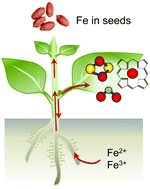当前位置:
X-MOL 学术
›
Metallomics
›
论文详情
Our official English website, www.x-mol.net, welcomes your
feedback! (Note: you will need to create a separate account there.)
Iron homeostasis in plants – a brief overview
Metallomics ( IF 2.9 ) Pub Date : 2017-06-28 00:00:00 , DOI: 10.1039/c7mt00136c James M Connorton 1 , Janneke Balk 1 , Jorge Rodríguez-Celma 1
Metallomics ( IF 2.9 ) Pub Date : 2017-06-28 00:00:00 , DOI: 10.1039/c7mt00136c James M Connorton 1 , Janneke Balk 1 , Jorge Rodríguez-Celma 1
Affiliation

|
Iron plays a crucial role in biochemistry and is an essential micronutrient for plants and humans alike. Although plentiful in the Earth's crust it is not usually found in a form readily accessible for plants to use. They must therefore sense and interact with their environment, and have evolved two different molecular strategies to take up iron in the root. Once inside, iron is complexed with chelators and distributed to sink tissues where it is used predominantly in the production of enzyme cofactors or components of electron transport chains. The processes of iron uptake, distribution and metabolism are overseen by tight regulatory mechanisms, at the transcriptional and post-transcriptional level, to avoid iron concentrations building to toxic excess. Iron is also loaded into seeds, where it is stored in vacuoles or in ferritin. This is important for human nutrition as seeds form the edible parts of many crop species. As such, increasing iron in seeds and other tissues is a major goal for biofortification efforts by both traditional breeding and biotechnological approaches.
中文翻译:

植物中的铁稳态——简要概述
铁在生物化学中起着至关重要的作用,是植物和人类必需的微量营养素。尽管地壳中含量丰富,但通常并不以可供植物利用的形式存在。因此,它们必须感知环境并与环境相互作用,并进化出两种不同的分子策略来吸收根部的铁。一旦进入内部,铁就会与螯合剂络合并分布到库组织,在那里它主要用于产生酶辅助因子或电子传递链的组件。铁的吸收、分布和代谢过程在转录和转录后水平上受到严格的调节机制的监督,以避免铁浓度累积到有毒过量。铁也被装载到种子中,储存在液泡或铁蛋白中。这对于人类营养非常重要,因为种子是许多农作物的可食用部分。因此,增加种子和其他组织中的铁含量是传统育种和生物技术方法生物强化工作的主要目标。
更新日期:2017-06-28
中文翻译:

植物中的铁稳态——简要概述
铁在生物化学中起着至关重要的作用,是植物和人类必需的微量营养素。尽管地壳中含量丰富,但通常并不以可供植物利用的形式存在。因此,它们必须感知环境并与环境相互作用,并进化出两种不同的分子策略来吸收根部的铁。一旦进入内部,铁就会与螯合剂络合并分布到库组织,在那里它主要用于产生酶辅助因子或电子传递链的组件。铁的吸收、分布和代谢过程在转录和转录后水平上受到严格的调节机制的监督,以避免铁浓度累积到有毒过量。铁也被装载到种子中,储存在液泡或铁蛋白中。这对于人类营养非常重要,因为种子是许多农作物的可食用部分。因此,增加种子和其他组织中的铁含量是传统育种和生物技术方法生物强化工作的主要目标。











































 京公网安备 11010802027423号
京公网安备 11010802027423号